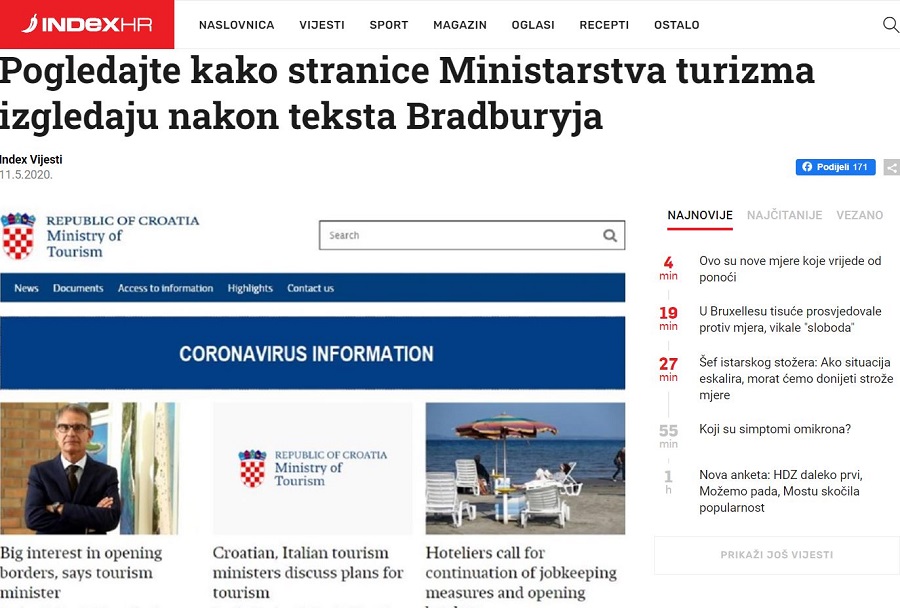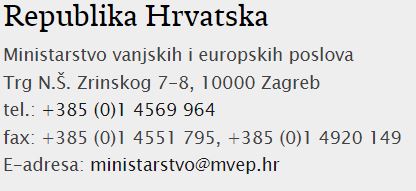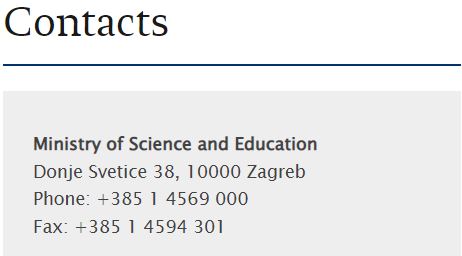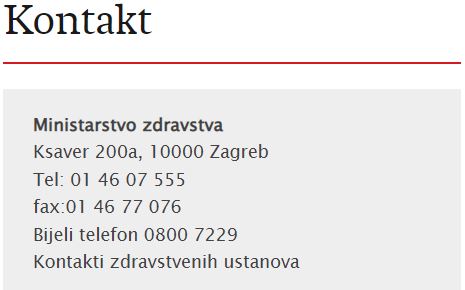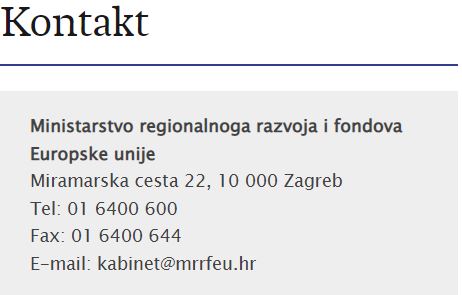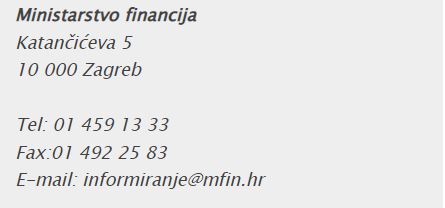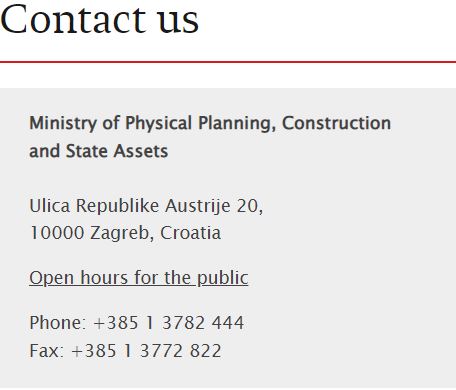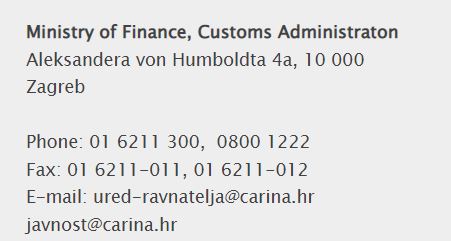Adriano Palman: Croatian Campsites Gain Impressive Tourism Results
January the 10th, 2022 - Croatian campsites have risen sharply in terms of their popularity ever since the coronavirus pandemic struck, with many preferring to be outdoors rather than stuck in hotels and complexes. They have achieved some truly impressive tourism results which were above all expectations.
As Novac/Jutarnji list/Barbara Ban writes, Croatian campsites, along with holiday homes, has proven to be the most sought after form of accommodation back during 2021's and previous pandemic-dominated tourist seasons. Croatian campsites performed excellently all summer long, but also after the height of the season passed. If the pre-season had been epidemiologically more stable, the results would have been even better.
The world of Croatian campsites cannot be dissatisfied with what they've managed to acheive, especially if numerous awards are added, both from Croatia and from abroad,. All of this was revealed by Adriano Palman from the Croatian Camping Association, which recently held its annual congress at the popular Terme Tuhelj.
How did Croatian campsites take advantage of another pandemic season in 2021?
In 2021, the Croatian camping sector realised as many as 91 percent of overnight stays when compared to the very good pre-pandemic year of 2019, and compared to 2020, we achieved exactly twice as many overnight stays. Realistically, we have to admit that it was expected that Croatian campsites would be one of the first forms of accommodation to be used when it comes to tourism recovery, but these results are above all of our expectations. The fact that there were a record number of German tourists in our campsites in 2021 speaks volumes about their quality, because never before have we had more German guests in the history of camping in this country.
Of course, there are several reasons for explaining such results, but, in particular, probably the first and main reason is that - as predicted at the beginning of the year - there is a great desire to travel and return to normal, and our warm sea and quality camping content which allows for a top quality holiday are certainly one of the first choices of guests, providing a holiday in the greenery with an increased sense of safety and isolation.
However, it should be honestly acknowledged that we aren't following some sort of exclusive trend and that the fact is that camping has become increasingly popular throughout Europe and there's been a real boom, as evidenced by record numbers in sales of camping equipment (campers, caravans, tents) in all major camping countries such as Germany, the Netherlands, Italy, Austria, neighbouring Slovenia, and even here in Croatia.
According to the German ADAC, which is still a ''guru'' when it comes to camping across Europe, Croatia is still second in the average quality of camping in Europe and third in the number of the best campsites that ADAC classifies under the ADAC Superplatz label. Thus, in 2022, Croatia will have as many as 21 Superplates, while two countries that have ten times larger capacities in camping have only a few more - France has 29, and Italy has 33.
What's the situation on Croatia's competitive markets?
One of the things that foreign experts pointed out to us at the recently concluded Croatian Camping Congress is that Croatian results were achieved at higher prices and without giving discounts that have often been applied by some of our competitors over these crisis years. So, when it comes to prices, it's important to emphasise that in 2021, we were second in Europe in terms of camping prices, right after Italy, which is 9 percent more expensive than we are, but we're significantly more expensive than Spain, which is 8 percent cheaper than us. In addition, France even reduced their prices by 5 percent in 2021. We know that in the conditions of intensifying competition, price positioning is an important factor and that is why we're even more convinced that our path is correct and that the very high average quality of Croatian campsites and what they offer provides a good basis and justifies our prices, which our guests have confirmed. This will hopefully continue to be the case as long as we have the right price-quality ratio.
What about the issue of the unresolved ownership issues of tourist land, which has often been a major barrier to investment...
Much like the entire tourism sector, Croatian campsites do have certain problems that hinder further development of competitiveness, and what is high up on that list is unresolved issues of tourist land. It wouldn't be correct to say that this has completely stopped investments. After all, quality indicators also refute this, but it's quite correct to say that this has conditioned the planning and implementation of investments in camping to an extent, while ideas and plans and already reserved funds were much higher. Therefore, we're pleased that in the coming months we definitely expect the adoption of the appropriate regulations that will properly regulate this issue and define the prices, which creates the proper preconditions for regulation and safety, which will certainly encourage an even greater investment wave and launch Croatian campsites and the whole sector very close to the first position in terms of quality in Europe.
In addition to that, another key issue that has plagued us for more than a decade now is the long and repeatedly announced adoption of the new Maritime Property Act, which is a very important topic for camping and a condition for maintaining competitiveness. Here, too, we can announce that cooperation has been established and that work on the new version of the Law is finally expected to begin at the beginning of next year, which will hopefully satisfy the interests of the public and provide Croatian campsites with the necessary competitiveness.
Further issues are also important, from labour shortages onwards, however, these are issues of general concern for tourism as a whole and are already being discussed on various sides.
What kind of camps does Croatia lack today, when looking at global trends?
In Europe, camps have been designed differently from the very beginning than in America or Australia. Sustainability and green business must play a key role in the development of camping here, and a concrete product in several typologies is built on them. The first and most commercially important is the sector of large camping resorts, which offer the widest range of services and very high quality, and the concept represents real hotels out in the open air.
Other routes are small, often family camps, camping resorts and similar sorts of facilities, which are located in attractive positions with natural beauty, urban and rural centres, intersections and traffic routes, islands and the like, and which provide a different kind of guest experience and emphasise intimacy, personal contact with the owners, socialising with other guests and joint activities. Such facilities are often simpler, and are especially important for the tourist development of continental Croatia and for the extension of the season, ie year-round work, which is still in its infancy in Croatia today, but for which there is truly exceptional potential.
Today's most modern and highly sought after trend, is glamping. Glamping mainly exists as part of the offer of the ''main'' camp, but there are more and more examples throughout Europe, including here in Croatia, that such an offer stands out from the rest and moves towards the independent development of specialised, exclusively glamping facilities.
Did we manage to raise what we have offer for the winter?
Year-round work is a relatively new trend in Croatian tourism in general, and it becomes even stranger when it is connected with the context of camps and the weather conditions of holidays which depend entirely on weather conditions. However, we still have prejudices against the outdated sun and sea system, while many European countries with poorer climatic conditions and no warm sea, such as Denmark, Germany, the Netherlands or Austria, have one of the strongest year-round camping scenes in all of Europe.
Today ,you can stay all year round in as many as 33 Croatian campsites from Istria, to Zagreb, all the way down to Dubrovnik and all the way to the East in Slavonia.
For more, check out our dedicated travel section.
Croatian Exports Jump, As Do Prices of Products Sold Abroad
January the 10th, 2022 - Some real pandemic growth can be seen when looking at the data for Croatian exports and their numbers for last year. Not only did Croatian exports jump, but the prices of various products sold abroad by Croatian enterprises also did.
As Novac/Jutarnji/Marina Klepo writes, last year, Croatian exports increased by more than a quarter: in the first eleven months of 2021, according to the CBS, they grew by 26.6 percent (25.4 percent in 2021's first ten months).
However, Croatian exports haven't increased significantly only compared to pandemic-dominated 2020, the Croatian Chamber of Commerce (HGK) pointed out, but their value in those first ten months of last year was 19.6 percent higher than back in the same period in pre-pandemic 2019. In addition, they added, Eurostat's data on the trade done by all EU member states shows that Croatia, both last year and a year earlier, was among the most successful EU countries.
"In the first ten months of last year, only Estonia and Greece had more dynamic export growth," they pointed out from the Croatian Chamber of Commerce. When we talk about the reasons for such good export results, we can mostly refer to the low base in the last, pandemic-dominated year.
Export structures
According to the Croatian National Bank (CNB), the high growth rates of merchandise exports and imports are only a small part of the positive effect of the base period. To a much greater extent, "they reflect the recovery of bith domestic and foreign demand, the partial re-establishment of supply chains, a stronger recovery of the manufacturing industry in relation to the service sector and a marked increase in global prices of energy and other raw materials," reads the latest publication. More detailed data on the structure of Croatian exports also reveal the reasons for their strong growth. When compared to the previous year, HGK analysts explained, the largest increases can be seen in the value of exports of energy - electricity, crude oil and petroleum products - which last year saw a significant increase in terms of prices on the vast global market.
Among the products whose export value increased the most were electrical equipment, followed by metals and finished metal products, whose prices on the global market also rose sharply. Available import price data for the Eurozone shows that crude oil imports rose by about 60 percent year-on-year in the first ten months of 2021, total refining industries rose by about six percent, petroleum products increased by about 40 percent, metals by about 30 percent and electricity by more than an impressive 150 percent.
"Therefore, even in the absence of more detailed data, it's more than noticeable that global prices last year had a significant impact on the growth of the value of Croatian exports," explained the Croatian Chamber of Commerce. Although strong growth is largely based on price increases, the Croatian Chamber of Commerce pointed out that there are a number of activities in which such price increases haven't been recorded, but which also record high export growth rates. These are, for example, the food, chemical and wood processing industries. In addition to that, a number of activities recorded significantly better export results than they did back in 2019, for example, agriculture, forestry and fisheries.
"This is at the same time a consequence of a strong recovery in global demand, but also a greater orientation of companies towards exports," the Croatian Chamber of Commerce said. The only activity that still recorded a significantly lower value of exports than in the same period in 2019 remained the production of motor vehicles and trailers.
Key markets
When it comes to the preferences of Croatian exporters, the figures suggest that last year they maintained their orientation towards the European Union's single market (EU) and what are traditionally the most important export markets. The share of Croatian exports to the EU market increased in the first ten months of 2021 from 68 percent in 2019 to 68.8 percent last year. The highest growth was achieved in the five most represented markets: Slovenia, Hungary, Italy, Bosnia and Herzegovina (non EU/EEA) and Germany.
For more, check out our dedicated business section.
Osijek Economic Centre Worth Over 687 Million Kuna on Horizon
January the 10th, 2022 - The Eastern Croatian city of Osijek is set to get a brand new Osijek Economic Centre worth more than 687 million kuna. This move will certainly work to boost entrepreneurship in this often wrongly overlooked city far from the coast.
As Poslovni Dnevnik/Suzana Lepan Stefancic/VL writes, the project for the preparation of documentation for the up and coming Osijek Economic Centre has been completed in its entirety, thus creating the preconditions for the construction of all buildings within the future complex. The design estimated value of the construction of the Osijek Economic Centre stands at the aforementioned figure of 687.50 million kuna.
''The preparation of project documentation for the Osijek Economic Centre is a complex and large project, and the design of it all as well as the securing of the necessary funds requires a lot of effort. In this project, funds are being jointly invested by Osijek-Baranja County and the City of Osijek. We've presented the documentation, ie the building permit for the entire project,'' said County Prefect Ivan Anusic at the final conference of the project.
The key to Eastern Croatia
He emphasised the fact that the future Osijek Economic Centre is of great value not only for Osijek-Baranja County and the City of Osijek but also for the whole of Eastern Croatia because, along with the Regional Distribution Centre for Fruits and Vegetables, it will become a key project for the development of this county and Osijek as a city. Osijek Mayor Ivan Radic said that the City of Osijek, as a partner in this project, donated land worth 26 million kuna, with another 15 million kuna provided through ITU mechanisms.
''I'm satisfied that everything is going according to the planned dynamics, and I'm convinced that the construction of the Osijek Economic Centre will encourage good economic trends in the city and county,'' said Mayor Radic.
Gabrijela Curkovic, Head of the Administrative Department for Investments and Development Projects of Osijek-Baranja County, pointed out that the recently completed task of dealing with all of the project documentation for the construction of the Osijek Economic Centre was co-financed by the European Union (EU), and that the work was done by the company Sirrah project from Osijek.
The total value of the project stands at 7,447,000 kuna, with 6,329,950 kuna having been co-financed by the EU, 756,525 kuna having been by the Ministry of Regional Development and EU Funds, and Osijek-Baranja County also provided 360,325 kuna.
The project holder is Osijek-Baranja County, and the City of Osijek is a partner.
''The Osijek Economic Centre will consist of several buildings, and the total area of the closed building itself covers 73,000 square metres, while 35,000 square metres will cover an area of open space,'' concluded Curkovic.
For more, check out our dedicated business section.
Croatia’s First High School for Classical Ballet to Open in Rijeka?
January 10th, 2022 - The City of Rijeka announced plans to open a high school for classical ballet, the first of its kind in Croatia. The City is also planning to introduce an elementary school programme in English in one of the schools in Rijeka
The City of Rijeka and Vežica Elementary School sent a letter of intent to the Ministry of Science and Education in which they expressed interest in establishing a new high school for dance in Rijeka.
Vežica Elementary School Principal Violeta Nikolić said there had been a need for a school of this kind for a long time now. Such an educational institution in Rijeka would be the first of its kind in Croatia, reports Novi list.
‘This year, the Elementary School for Classical Ballet and Contemporary Dance [in Rijeka] marks its 15th anniversary. In those 15 years, around twenty of our pupils had to continue their education in Zagreb or abroad. Namely, students are leaving for Ljubljana, Milan and Budapest. There is interest in higher education, and if Rijeka had its own school, there would certainly be even more interest. The idea is to open a four-year vocational school after which our students could find employment right away. The school would have two departments, for contemporary dance and classical ballet. It would be the first such school in Croatia’, explained Nikolić.
The principal believes that the new school would certainly attract students, not only from Primorje-Gorski kotar county, but from other parts of Croatia as well. Asked about the personnel that would work in the future school, she said this definitely wouldn’t be an issue as they already have staff that are experts in the field of dance. ‘A high school would only be an extension of what we’ve already been doing for 15 years’, said Nikolić.
The City is on board with the plan, according to Rijeka Deputy Mayor Sandra Krpan, who said the City would find a location for the future school. It wouldn’t be implemented in Vežica Elementary School, but would be an autonomous institution located in the city centre.
‘We embraced the idea of establishing a dance school right away. We’re also planning an expansion of Elementary School Vežica to fit the needs of the Elementary School for Ballet’, said Krpan, adding that the funds for the school expansion have already been set aside in this year’s city budget.
That’s not the only new school the City of Rijeka has in the works, as there are plans to open a new elementary school that would offer a programme in English. Krpan explained that establishment of a new educational institution wouldn’t be necessary in this case, as the new programme would be implemented in one of the existing schools in Rijeka.
‘Rijeka is developing, international companies are increasingly present and we believe that there’s a need for an elementary school programme in the English language. We would introduce it from the first grade of elementary school. We believe that personnel won’t be a problem’, said Krpan, adding that they haven’t yet decided which school would offer the new programme and that it might be implemented in multiple schools.
Croatian Football Federation Introduces Vatreni Crypto Token
January 10, 2022 - HNS joins the technological revolution in international football. In cooperation with two Croatian companies - AMPnet and Biznisport - the Croatian Football Federation introduces the loyalty Vatreni crypto token and mobile application.
HNS will thus give millions of loyal Croatia fans more opportunities to interact with players, participate in HNS decisions, and other opportunities that will be exclusively available only to owners of the Vatreni crypto token, writes the Croatian Football Federation.
"By stepping into the crypto market, we are following global trends, and we want to connect even better with our fans and provide them with opportunities they have not had before. I am especially proud to work with Croatian companies in this project because we believe that Croatian knowledge in IT is absolutely competitive and that we get partners who are equally committed to cooperation like us," said the president of HNS Marijan Kustić.
The official crypto partner of HNS is the Croatian company AMPnet, which provides its technology exclusively for tokens.
"Thank you, HNS, for your cooperation and shared desire to provide all fans of the Croatia national football team with an even better experience with the Vatreni loyalty token. With the support of HNS and the integration of AMPnet technology and Biznisport partners, we will be able to participate in making certain decisions, the right of priority when buying tickets, and discounts with HNS partners.
They will also have the opportunity to win, earn or buy exclusive products not available elsewhere. In addition, the token owner will be able to use the token for payment because it is compatible with Electrocoin's Paycheck application, which allows cryptocurrency payments in more than 200 places, such as Konzum, Ferivi, Ulaznice.hr, Football Mania, Sancta Domenica, Hrvatska pošta and others," said AMPnet CEO Mislav Javor.
The pre-sale of a limited number of Vatreni loyalty tokens is not yet available to everyone. All those interested in buying the token can get more information and apply for the waiting list here: https://token.hns-cff.hr
Important note:
Vatreni crypto token is, by its nature, a cryptocurrency. Investing in cryptocurrencies is extremely risky and should not be undertaken by anyone who does not have enough knowledge. The cryptocurrency market is only partially regulated, so potential investors cannot count on all forms of protection available to them in the traditional financial market. If you do not master the matter so that you know how to receive cryptocurrencies on a digital wallet and keep them safe, do not indulge in investing in cryptocurrencies.
To read more about sport in Croatia, follow TCN’s dedicated page.
Croatian-Argentine Artist Exhibition in Pula: Christmas for Croats - Nativity Scenes and Folk Customs
January 10, 2022 - Jadranka Relota, a Croatian-Argentine artist, presented an exhibition of paintings - miniatures on glass "Christmas for Croats - nativity scenes and folk customs" from the 2021 holiday season until Sunday, January 9, 2022, in the Capitular Hall of the Monastery and Church of St. Francis in Pula. The exhibition was organized by the Croatian Heritage Foundation - Pula Branch.
The exhibition presented a kind of hommage and a suggestive presentation of Advent and Christmas customs, which include all parts of Croatia through a visible wealth of traditions, folklore, and ways of living in various geographical areas of Lijepa Naša. The exhibition included about thirty paintings on glass - miniatures, 18 x 13 centimeters, and these works were created in the period from 2017 to the present. The special feature of the exhibition was that it included almost all parts of Croatia (Istria, Susak, Krk, Pag, and Lika, Dalmatia, Podravina, Međimurje…), but also areas outside Croatia where Croats live (such as Vojvodina, Bosnia and Herzegovina, Argentina).
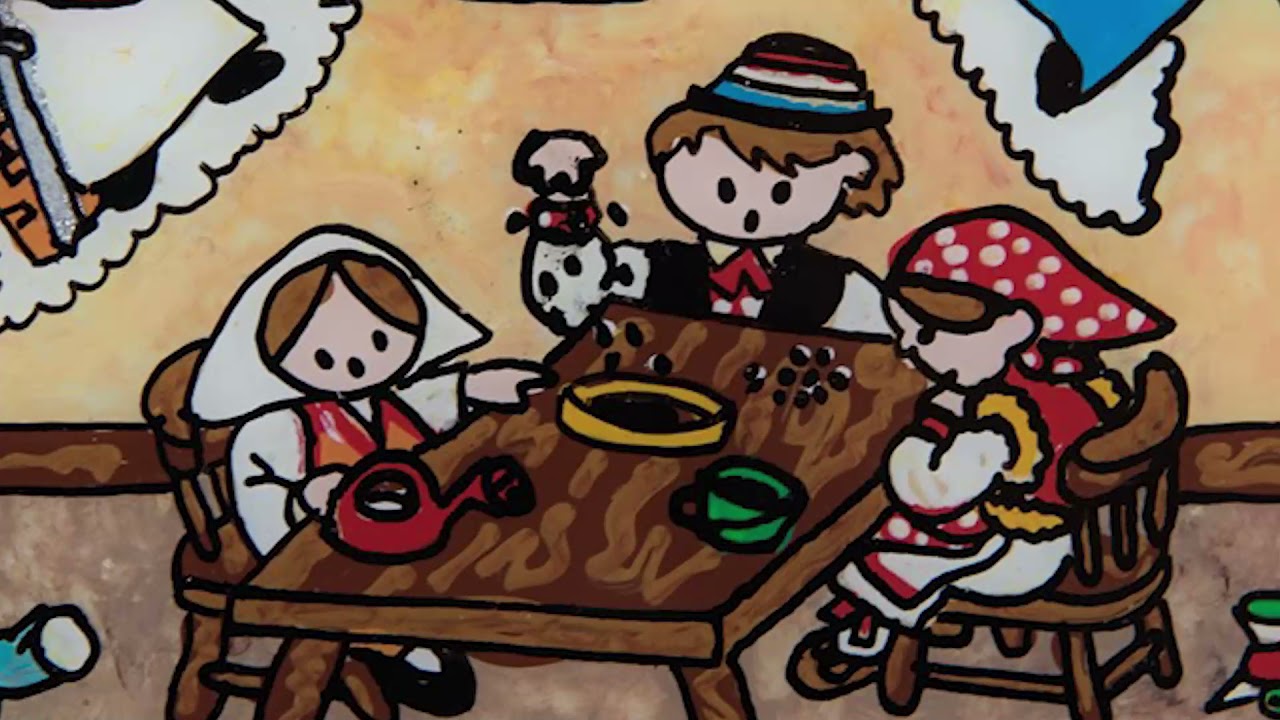
The motives of her works are the blessing of houses and families, caroling, and the author took care to present motives characteristic for a particular place, region or region. For example, Istrian kažun, Paška čipka, Sinjska alka, Šestine umbrella were presented, and the characters of Mary and Joseph were dressed in traditional costumes of these areas, providing insight into the richness and diversity of Croatian cultural heritage and its regions.
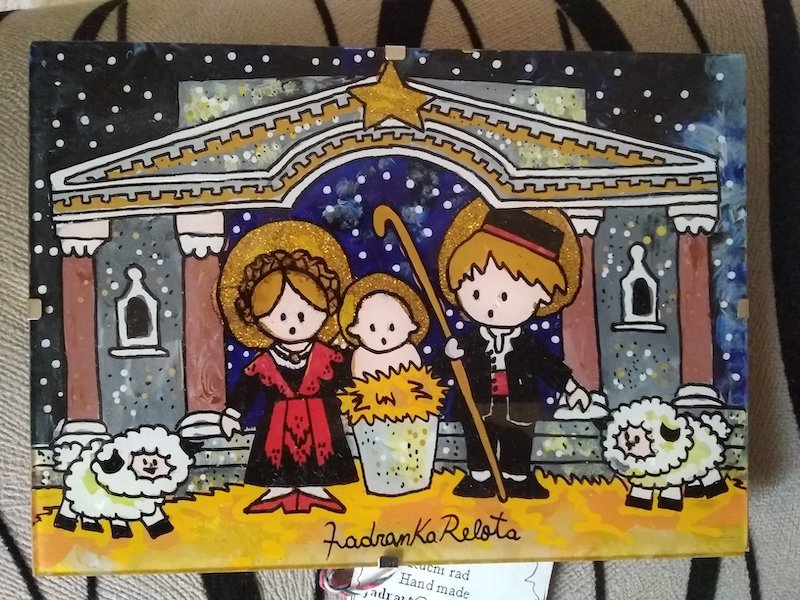
Jadranka Relota is a self-taught artist, an Argentine with Croatian roots, who has been living and working in Pula since 2016. Shee makes miniatures on glass in the naive style, miniatures on canvas and wood, Easter eggs, Istrian souvenirs and other handicrafts inspired by Croatian heritage. In addition, she has been studying and affirming Croatian ethnographic heritage for years and has held several workshops on making Easter eggs and painting on glass in Argentina and Croatia.
To read more about lifestyle in Croatia, follow TCN's dedicated page.
Croatians in Switzerland: Job Market Open for Busy Winter Season
January 10, 2022 - Croatians in Switzerland have been free to work since January 1, and many workers are making the movie for well-paid winter jobs.
Switzerland opened its job market for Croatian workers on January 1, 2022, making them equal to other citizens of EU member states. According to the latest official data, slightly less than 30,000 Croats already work in Switzerland, reports Index.hr.
Index has learned from Nataša Kačar, the owner of the Jobs in Tourism portal and employment agency, that the first workers from the hospitality sector have come for the winter season.
The need for workers in Switzerland, she says, is excellent, so she has published ads for chefs, assistant chefs, waiters, and bartenders from Croatia who want to work in Swiss hotels during the winter season.
In an interview with Index, she revealed the working conditions for Swiss employers and what interests them the most - the salaries.
"We published on our Facebook page a competition for catering workers for the winter season in Switzerland in 2021/2022. The interest is really high. Salaries range from 3900 to 4300 euros gross for chefs, with the proviso that these are auxiliary, not head chefs. Salaries of bartenders and waiters range from 3,900 to 4,400 euros gross plus tips. It is done in hotels, boarding houses, and a la carte restaurants. The work is until April 20, 2022. Still, with certain hotels, there is also the possibility of agreeing on a permanent employment relationship, with a probationary period of three months," said Nataša Kačar for Index.
As for working conditions, she states that working hours are 9 hours a day, with a 50-minute break. Therefore, they work 45 hours a week with two days off.
The prerequisites are vocational school, minimum experience of 1 to 5 years, and knowledge of German. As for chefs, they may have lesser knowledge of German, in the B1 level, while waiters and bartenders are required to have an excellent understanding of German (B2).
"The Swiss are strict, they do checks, and if it turns out that a person doesn't know German, they won't be able to get a job even if they are the most qualified in their job. For example, the other day, I conversed with a man who worked in excellent restaurants in Croatia and is really qualified; he said he knows German. But after the job candidate interviews with me, he interviews my colleague from Switzerland who makes the further selection and tests his knowledge of German. That candidate, as it turned out, still did not know German and, despite the qualifications, did not get the job," Nataša said.
She states that another condition that all candidates must meet has a Covid certificate.
As far as the staff required by the Swiss are concerned, preference is also given to candidates with experience working in hotels and on 4- and 5-star ships. Applicants must submit a detailed CV in German with a photo, and the highest quality candidates will be allowed to speak to their employer via Skype. They are required to be qualified for the job.
"The Swiss provide accommodation to candidates at a surcharge of 380 to 570 euros a month and food at a surcharge of 280 to 430 euros a month. As for the net salary, it is reduced from 13 to 20 percent gross, depending on the region. We are looking for staff to work in Bern, Zurich, Lucerne, Valais, Schwyz, and Graubünden," said Kačar.
A look at the net earnings after deducting accommodation and food allowances.
A salary of 3900 gross is reduced by 13 percent, making the net salary around 25,000 kuna. After a person pays a total of 660 euros for accommodation and food, or about 5,000 kuna (the minimum amount as an example), the net salary is 20,000 kuna.
This is just one example; net earnings can vary depending on multiple parameters.
In addition to mediating the employment of Croatian workers abroad, mainly in Switzerland, Austria, and Germany, Nataša Kačar is also looking for workers for hotels and restaurants in Croatia, so she is aware of the differences in salaries and working conditions abroad and in Croatia.
"I get inquiries in Croatia where they ask me for a worker who would work their season on the Adriatic without days off. The catering industry in Croatia needs to change; employers need to offer normal conditions. People would stay in Croatia for seven thousand kuna, but normal working weeks, two days off, normal working hours are given," Kačar pointed out.
She states that many people who worked in the hospitality sector changed jobs during the pandemic when restaurants were closed in Croatia.
"Then they saw what it's like to have a private life, what it's like when they have days off, and they don't want to return to catering anymore. However, it should be emphasized that they are not paid for the main reason, but working conditions," said Kačar.
The interest in working abroad, specifically now in Switzerland, is excellent during that time.
"We have good candidates, but the only problem is that few people know German, and the Swiss are looking for actual knowledge of German, especially for waiters and bartenders. I have been hiring workers in Switzerland for the last five years. Then, as the pandemic started, Switzerland closed all quotas, and Croatians could not be employed there, and now they can again.
Indeed, thousands of Croatian citizens will find a job in the hospitality sector in Switzerland, and according to the information I have, since March, the influx of Swiss companies to construction workers from Croatia has started. There will be a lot of work, thousands of workers are looking for work, not only in the catering industry, but knowledge of German is crucial," Kačar points out.
A good opportunity is also provided to nurses, who, as she says, have twice the salaries of those offered in the hospitality industry.
She also states that the procedure for employment in Switzerland is far faster than in Croatia.
"Here, a maximum of two weeks ago, I was contacted by some candidates who want to go to Switzerland, and some have already sorted out all the paperwork and left, and some are going next week. But knowledge of the language is crucial," she said.
She also states that residents of Croatia, from Slavonia to Dalmatia, are showing interest in working in Switzerland. In addition, she noticed that women have been calling them a lot lately. Before, it was primarily men.
"They are calling us from all over Croatia. Some are only looking for work in the winter because they already have an agreed summer season in Croatia. We get a lot of calls from women, that's a change as before men always called. I was contacted by women from Slavonia, they would go to Switzerland permanently. There are a lot of those who want to move out and are looking for permanent jobs because salaries in Croatia are too low during the season, and working conditions are worse. Therefore, it is not surprising that there is a great interest in emigrating to Switzerland, Austria, and Germany," she said at the end of the conversation.
The most famous Swiss job search portal currently offers 90,640 vacancies. In addition to workers in the hospitality industry, Switzerland is most in demand for nurses, construction workers, followed by skilled workers in engineering, financial services, and the IT sector.
According to the jobs.ch portal for nurses in Switzerland, the average annual salary is 78,853 Swiss francs gross (568 thousand kuna). For doctors, it is about 130 thousand francs gross (915 thousand kuna).
Depending on occupation and skills, salaries in the IT sector range from 64,500 Swiss francs gross (450 thousand kuna), which is the lowest average, to 203,000 Swiss francs gross (about 1 million and 400 thousand kuna), which is the highest average.
Construction workers earn an average of 62,400 Swiss francs gross (HRK 440,000) a year.
The cost of living is high in Switzerland.
According to the Numbeo portal, which collects data on the cost of living worldwide and provides comparisons, life in Switzerland is on average 153 percent more expensive than in Croatia. In contrast, renting apartments is 300 percent more costly than in Croatia.
The estimated monthly expenses of a family of four are HRK 38,452.87 (5,323.20 Swiss francs) without rent. Estimated monthly expenses for a single person are HRK 10,432.99 (1,444.28 francs), also without rent.
The monthly rent for a one-bedroom apartment in Swiss cities outside the center averages HRK 8,463, while in the center, it is around HRK 10,800.
Comparing the two largest Swiss cities - Basel and Geneva, consumer prices in Basel are 13.52 percent higher than in Geneva (excluding rent). Still, apartment rentals in Basel are as much as 35.17 percent lower than in Geneva. As for prices in restaurants, they are 3.86 percent higher in Basel than in Geneva, and in Basel, groceries are also more expensive - 18.19% higher than in Geneva.
As for living in Zurich, the estimated monthly expenses of a family of four are HRK 41,567.97 (5,754.43 Swiss francs) without rent. One person's estimated monthly cost of living is HRK 11,267.44 (1,559.80 Swiss francs), also without rent. Zurich is 166.61 percent more expensive to live in than Zagreb, while rent in Zurich is on average 305.50 percent higher than in Zagreb - it costs about 2,000 Swiss francs (HRK 14,000) per month.
For more, check out our business section.
New January COVID-19 Measures in Croatia from Today: What to Expect
January 10, 2022 - A look at the January COVID-19 measures in Croatia in force from today.
Given the large number of newly infected patients in Croatia, new epidemiological measures come into force on Monday, which will further restrict gatherings and ensure more intensive control of catering facilities.
According to a new decision by the National Civil Protection Headquarters, public gatherings and outdoor events for more than 50 people (so far 100) are prohibited, and those with Covid certificates and with the consent of local headquarters are limited to 200 people.
Indoor gatherings of more than 25 people (50 so far) are prohibited, and those with Covid confirmations are limited to 100 people.
The new measures are also in force for private gatherings, allowing a maximum of 20 people (so far 30). In cases where everyone has a Covid certificate, 50 people will be able to attend the private gathering.
No changes have been introduced in the work of catering facilities, but restrictions on the number of guests, maintaining a physical distance of 1.5 meters and using masks while sitting at a table, and ventilating and cleaning the premises will be more intensively controlled.
As of today, the number of spectators at sports competitions is limited, so a maximum of 20 percent of individual grandstands can be filled indoors, and up to 40 percent of outdoor grandstands.
Citizens must wear masks at religious ceremonies and art programs, cinema screenings and exhibitions, and at sessions of representative bodies regardless of having a Covid certificate.
Also, the obligation of employers to organize work from home whenever possible has been introduced.
Furthermore, Minister of Science and Education Radovan Fuchs reaffirmed the return to school classes in Croatia from Monday. He also added that there will be mandatory masks in Croatian schools for those in fifth grade and up, among other considerations.
According to the latest data, there were 44,633 people suffering from Covid-19 in Croatia on Sunday. Among them, 1,874 patients are in hospital, of which 242 are on respirators. There are currently 19,072 people in self-isolation. Nearly 45,000 new cases were reported last week, up 61 percent from the week before.
It is estimated that the new wave will put additional pressure on the health system, especially in Dalmatia.
For all you need to know about coronavirus specific to Croatia, make sure to bookmark our dedicated section and choose your preferred language if it isn't English.
Long Live the Fax! Cutting Edge Comms in Croatian Ministries in 2022
January 9, 2022 - The year is 2022, and in the Mighty State of Uhljebistan, the fax machine reigns supreme.
When was the last time you sent a fax?
Have you ever sent a fax?
Do you even know what a fax is?
Or what a fax machine looks like?
If you are dealing with Croatian bureaucracy in the year 2022, ignore the power of the facsimile at your peril, for it is still one of the prime sources of communication in a digital age which has no idea what the fax dinosaur is or actually does.
It is almost two years since I wrote An Ode to the Fax, the Digital Champion of Uhljebistan 2.0.
And full credit to the Ministry of Tourism and its previous minister, Gari Cappelli, which abolished the fax machine and had a website upgrade within 10 minutes of my article being republished on Index.hr.
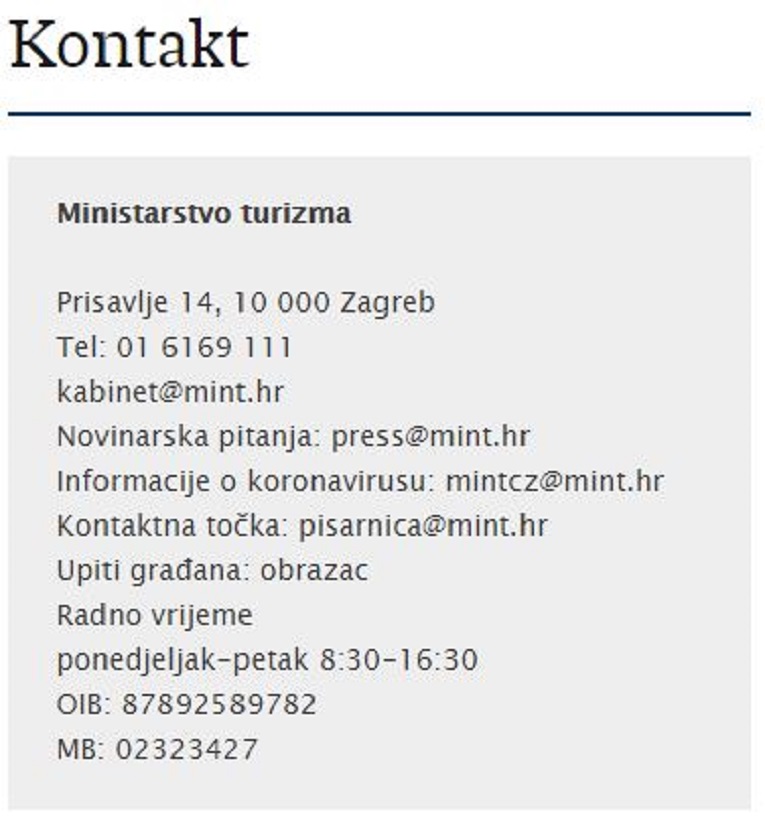
A great example of a responsive ministry willing to take on board criticism and move with the times. No more fax numbers, but an impressive number of email contacts, depending on your interest.
Time passed in The Beautiful Croatia.
There were many technological developments, and even some public-private partnership innovation, such as the introduction of the digital nomad permit in less than 5 months from announcement to realisation.
In a normal country, the abolition of the fax machine by the Ministry of Tourism might be seen as an initiative to emulate. So how do things look in the Mighty State of Uhljebistan in early 2022, a year after Croatia held the EU Presidency? We were a little bored this Sunday so decided to cruise the home pages of the official Croatian ministry websites. Here is what we found...
The absolute winners of the Croatian Ministry 2022 Fax Challenge are the Ministry of Foreign Affairs. Not one, but TWO fax numbers! If Putin decides to invade Ukraine, we have all communication bases covered. Good job!
The standard of education in Croatia is sometimes criticised, but 12 points for the Ministry of Education. How many other countries will have kids who have heard the word Fax?
Feeling a little under the weather and in need of help? The Ministry of Health is just a facsimile away.
Ah yes, the elusive EU funds racket. Document this required, document that. Why not cut through the red tape and just send them a fax? The billions are sure to follow.
Talking of billions, the Ministry of Finance takes the fax story to the next level - where else can you find a fax number in italics in 2022?
Perhaps we have stumbled upon a clue as to why construction permits are taking so long in Croatia.
Or why the agricultural sector is so sluggish.
Or why your Christmas present has not yet arrived.
The Mighty State of Uhljebistan 2.0, I salute you - you obviously have your internal comms very well organised. But tell me, how do you communicate with the citizens who have never been exposed to your powerful fax communication tool?
Weather Lore in Croatia: Lokve Folk Calendar Predicts the Weather in 2022
January 9th, 2022 - How did people go about predicting the weather back in the day, before the invention of measuring instruments? Looking into a traditional method preserved in Lokve, a town in Gorski kotar where folk meteorologists predict the weather for the year ahead based on a short period in December
We’re a bit spoiled these days with detailed weather forecasts awaiting only a few clicks away. Have you ever wondered how people used to go about this before weather apps and modern meteorology? With no measuring instruments yet invented, they had only their environment and the skies above to rely on, giving way to a diverse body of weather folklore.
There are many folk sayings and customs related to weather in Croatia - too many for a single post. This time, we’ll focus on an old tradition that’s been passed down for generations among the people of Lokve, a town in the Gorski kotar region.
Called ‘brojanica’ in Croatian, the traditional method allows for predicting what the weather will be like in the entire year based on a short period in December - a fine example of weather lore preserved to this day.
Local folk meteorologists in Lokve carefully track weather conditions and changes during the 12 days between the holiday of St Lucia (December 13th) and Christmas Eve (24th). Each of those days is associated with one of 12 months in a year; the weather conditions recorded on a given day are taken as a forecast for the whole related month, with some adjustments to fit the different seasons. E.g. if it’s cold and sunny on St Lucia, it’s expected that the whole month of January will be cold and sunny as well.
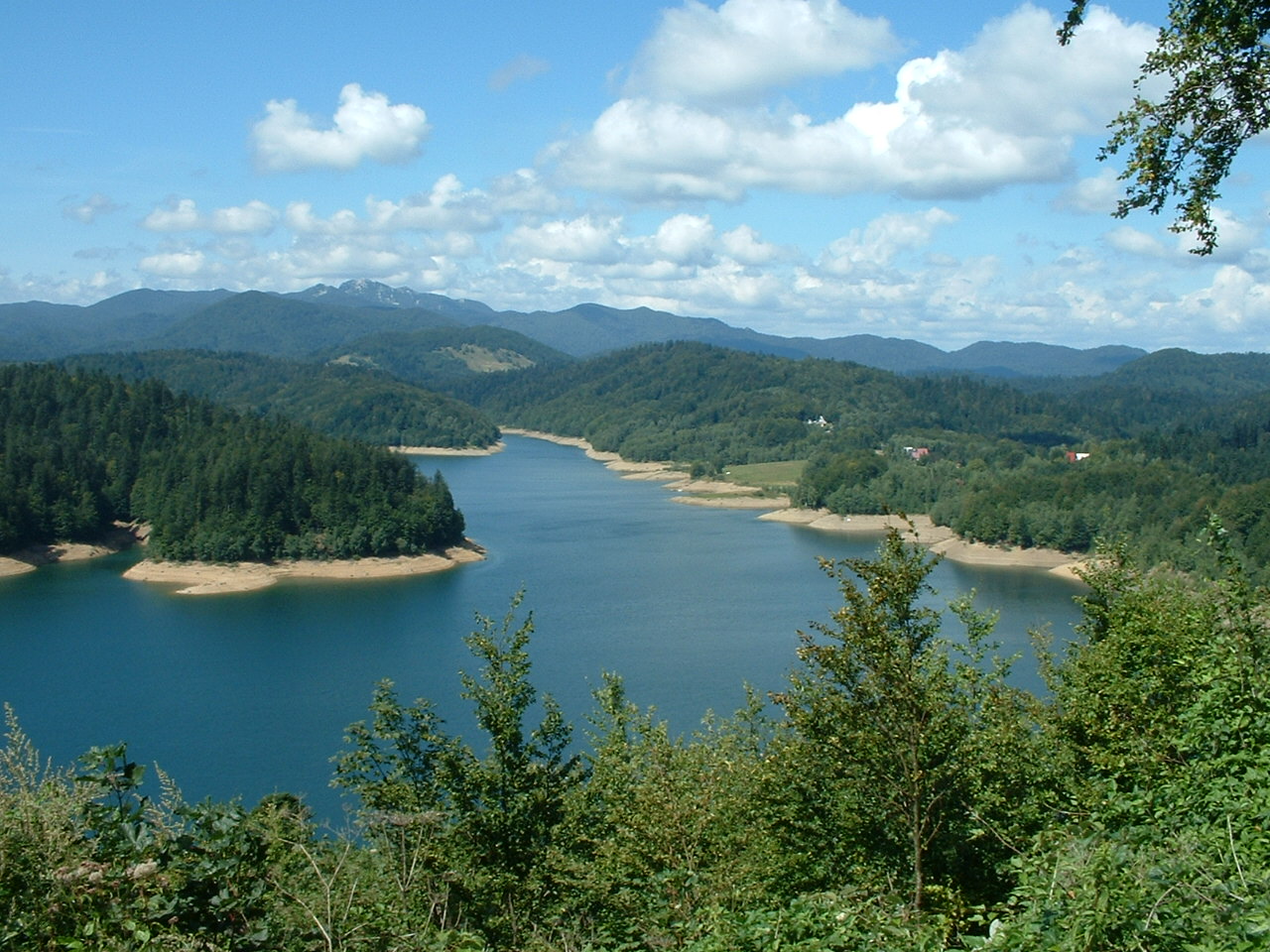
Lake Lokve / velfran
Novi list reported that the diligent folk meteorologists in Lokve kept a close eye on the weather this past December as well, resulting in publication of the 2022 Lokve calendar with the forecast for the entire year.
What awaits us in 2022? The calendar designer Nikola Pleše says we don’t have to worry about extreme weather this year.
‘Tracking of the weather conditions between St Lucia and Christmas Eve has shown that those 12 days didn’t bring any extremes, so based on our tradition and folk wisdom, we don’t expect anything too dramatic in regards to weather conditions this year’, he said.
The forecast for January has already proven to be true. ‘In the first week of the new year, St Lucia will unfurl a tall, grey fog over Lokve and only show us sunlight and moonlight in traces. From the 20th of the month, days will be clearer and calm, but colder’, says the calendar. And even though this refers to Lokve in particular, the nearby Kvarner bay has also been completely enveloped in thick fog for the first week of 2022.
In the poetic forecast for the month of February, it’s said that ‘the skies will hide behind a tall, thick fog, in which not even little birds will dare to make a peep. From February 15th onwards, the sun will rip the fog apart…’.
Not much for the people of Gorski kotar to look forward to in March either: ‘Days will remain drooly, full of fog, adorned by a rare snowflake or glistening frost’, up to March 20th when the northern winds are expected to sweep the fog away.

Come April, the weather will finally start looking up, and in May, ‘days will be bright and warm, making people, birds and plants more cheerful.’ This trend will keep up in June, as the month is to be ‘sunny and dry, already in full bloom by Midsummer’s day (Ivanje), and more humid and hot towards St Peter’s Day (Petrovo).’
A lot of wonderful summer weather in July and August as well, leading to a bountiful harvest in September. ‘It will be a sunny, clear month, smelling of the abundance of everything we’ll have planted in Lokve soil this spring’, says the forecast.
And that’s about it when it comes to nice weather in Lokve this year. The last three months of 2022 will supposedly be quite damp, same as in the beginning of the year. A lot of fog, frost, and cold wind are expected in autumn, but it won’t be too cold until late December when the southern jugo wind will be replaced by the dry bura wind that will have the temperature drop sub zero and usher in the winter season.
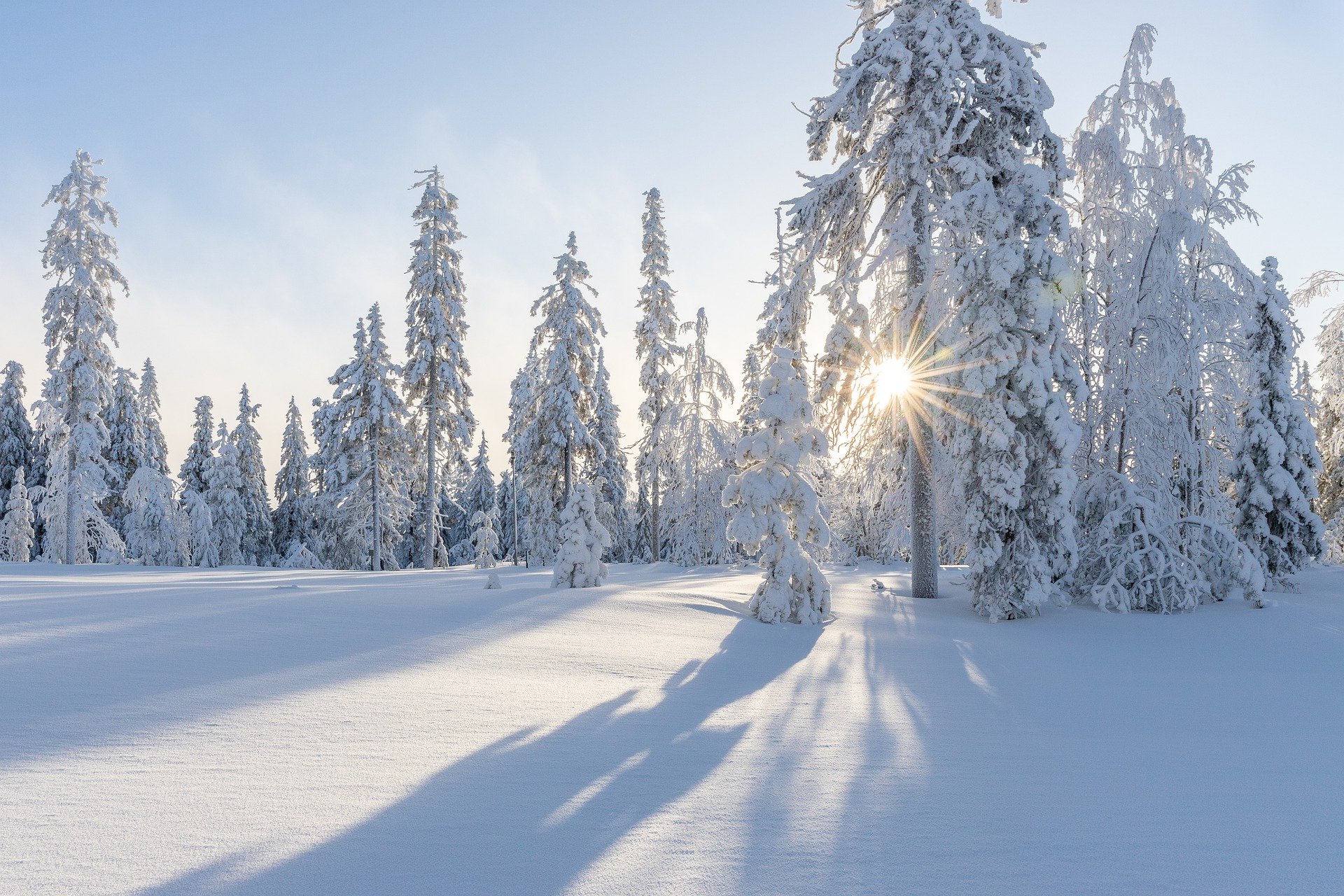
The weather forecast for this year’s weather calendar was created by Mirjana Pleše and her daughter Ivana, Andreja Marković, Tanjica Šafar, Marijana Rakas and Eleonora Grgurić, with Nikola Pleše behind the calendar’s graphic design.
Beyond the folk traditions, Lokve is a fantastic destination for a day trip that will delight any fans of outdoor activities. The town is home to the cave Lokvarka, the deepest cave in Croatia open to the public. Not a fan of subterranean strolls? Head to the nearby Lake Lokve (Croatian: Lokvarsko jezero) for a scenic walk or a bike ride with a view. Make sure to contact the local tourist board beforehand, though - the (artificial) lake will be drained for a period of time in 2022 for regular maintenance, so you might as well know what kind of view to expect during your visit!


